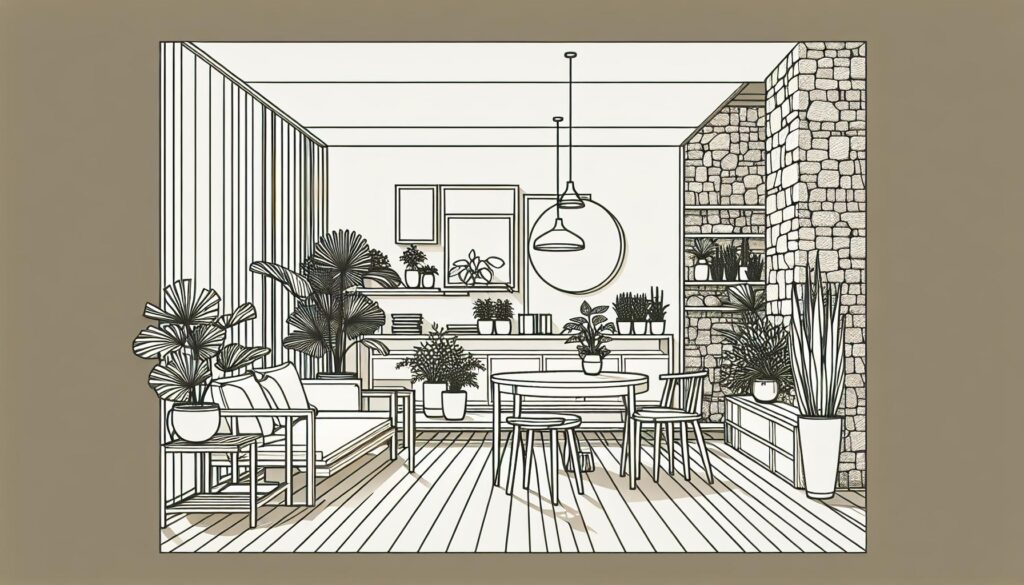Are you intrigued by the idea of minimalist interior design but not sure where to start? As a seasoned interior design blogger, I’ve delved deep into the principles and tips that can help you achieve a sleek and clutter-free living space.
In this article, I’ll guide you through the core principles of minimalist interior design, from embracing simplicity to focusing on functionality. With my expert tips, you’ll learn how to create a calming and visually appealing environment that reflects your unique style and personality.
Embracing Simplicity
When it comes to minimalist interior design, simplicity is key. I always prioritize clean lines, uncluttered spaces, and a restrained color palette. To achieve this look, I focus on functional furniture with simple designs that serve a purpose without unnecessary embellishments.
In my experience, decluttering is essential to embrace simplicity. I recommend organizing and prioritizing essentials, getting rid of anything that doesn’t add value to the space. This creates a calm and balanced environment that is both visually appealing and practical for everyday living.
Another aspect of embracing simplicity is limiting decorations. I opt for minimal decor pieces that have meaning and significance, rather than overcrowding the space with unnecessary items. This allows each piece to stand out and adds a personal touch to the room without overwhelming the senses.
In minimalist interior design, less is often more. By embracing simplicity, you can create a living space that feels open, airy, and peaceful. The focus is on quality over quantity, ensuring that every element in the room serves a purpose and contributes to the overall harmony of the space.
Decluttering Your Space
When it comes to minimalist interior design, decluttering is key to achieving a clean and streamlined look in your living space. Clutter not only creates visual noise but can also hinder functionality and peace of mind. Here are some tips for effectively decluttering your space:
- Start by assessing each room and identifying items that are unused or do not serve a purpose.
- Organize belongings into categories to make it easier to declutter efficiently.
- Consider adopting storage solutions such as hidden cabinets or multi-functional furniture to keep items out of sight.
- Embrace a “less is more” approach by curating your belongings and only keeping items that spark joy or hold significant meaning.
- Regularly evaluate your possessions and be willing to part ways with items that no longer align with your vision of a minimalist living space.
By simplifying and streamlining your possessions, you can create a space that feels calm, balanced, and inviting.
Focusing on Functionality
When it comes to minimalist interior design, one key principle is Focusing on Functionality. This means that every item in your space should serve a purpose and contribute to the overall functionality of the room. Here are some essential tips to help you achieve functionality in your minimalist design:
- Multi-functional Furniture: Opt for furniture pieces that serve more than one purpose, such as a storage ottoman or a bed with built-in drawers.
- Open Space: Embrace open space to allow for better flow and movement within the room. Avoid overcrowding the space with unnecessary items.
- Clear Pathways: Ensure that there are clear pathways throughout the room, making it easy to move around without obstacles.
- Purposeful Decor: Select decor items that not only enhance the aesthetics of the room but also serve a functional purpose, such as floor mirrors that also act as storage space.
By prioritizing functionality in your minimalist interior design, you can create a space that not only looks visually appealing but also serves your practical needs effectively. Remember, minimalism is not just about aesthetics but also about creating a space that works well for you.
Utilizing Neutral Colors and Clean Lines
When it comes to minimalist interior design, utilizing neutral colors is key for creating a calming and cohesive space. I opt for tones like white, beige, gray, and taupe to establish a soothing backdrop. By keeping the color palette simple, I ensure that the focus remains on the clean lines and functionality of the furniture and decor.
Clean lines play a crucial role in achieving a minimalist aesthetic. I choose furniture with straight edges and simple silhouettes to maintain a sense of clarity and order in the room. This design choice eliminates visual clutter and promotes a sense of tranquility within the space.
To enhance the visual impact of clean lines, I pay close attention to details like symmetry and balance. Symmetrical arrangements create a sense of harmony, while balanced compositions contribute to a feeling of stability and serenity.
Incorporating minimalist art pieces that feature simple geometric shapes or abstract patterns can also complement the clean lines in the design. These artworks add visual interest without overwhelming the space, serving as focal points that enhance the overall aesthetic.
When selecting decor elements, I prioritize quality over quantity to maintain a streamlined look. Opting for functional decor items that serve a purpose ensures that every piece in the room contributes to both the visual appeal and the functionality of the space.
Incorporating Natural Elements
When it comes to minimalist interior design, incorporating natural elements is key. I love bringing in elements like wood, stone, or plants to add warmth and texture to a space. Natural materials not only add a touch of nature indoors but also help create a sense of balance and harmony.
Here are some tips on how to incorporate natural elements into your minimalist design:
- Wood: I often opt for wooden furniture or accents to bring a sense of warmth to a minimalist space. Whether it’s a sleek wooden coffee table or rustic wooden shelves, the natural grain and tones of wood can add depth and character to the design.
- Plants: Adding houseplants is a great way to bring life and greenery into a minimalist space. Plants not only freshen the air but also act as natural decor elements that can soften the clean lines of minimalist design.
- Stone: Incorporating stone elements like a marble countertop or granite accents can introduce a sense of luxury and timelessness to your space. The natural textures of stone can create visual interest and contrast in a minimalist setting.
Incorporating these natural elements not only enhances the aesthetic of your space but also fosters a connection to the outdoors, promoting a sense of serenity and calm within your home.
Key Takeaways
- Embracing simplicity by prioritizing clean lines, uncluttered spaces, and a restrained color palette in minimalist interior design.
- Effective decluttering techniques involve assessing unused items, organizing categories, and curating belongings to create a calm and balanced living space.
- Focusing on functionality ensures that every item serves a purpose and contributes to the overall practicality of the room.
- Utilizing neutral colors and clean lines is essential for creating a soothing backdrop and maintaining a minimalist aesthetic.
- Incorporating natural elements like wood, plants, and stone can add warmth, texture, and balance to a minimalist space.
Conclusion
Incorporating natural elements like wood, plants, and stone into minimalist interior design is key to creating a harmonious and balanced space. Wood adds warmth and character, while plants bring life and softness to clean lines. Stone elements like marble or granite can elevate the design with luxury and visual interest. These additions not only enhance the aesthetic appeal but also establish a connection to nature, promoting a sense of tranquility within the home. By embracing these principles, one can achieve a minimalist design that is both visually striking and emotionally comforting.



